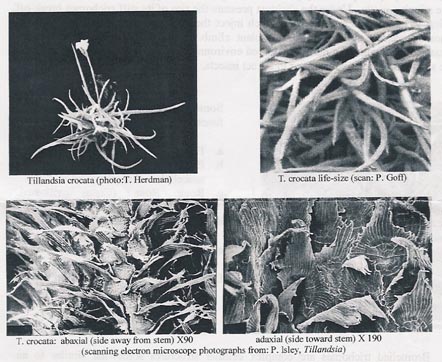| |
|
by Penrith Goff, S.E.Michigan Bromeliad Society |
|
|
|
|
The
epidermis of many plants grows attachments consisting of one or more cells and taking many
different forms. These attachments are called trichomes (TRIH-combs), a word derived from
Greek "hairy" and indeed, the trichomes we are most familiar with are the ones
which give plants a downy or furry appearance. The Great Mullein, for example, or
artemesia and the many other plants which grow under hot, arid conditions are covered with
"hair" which protects against the glare of the sun, shelters against drying out
in the wind, and helps perhaps to keep predators at bay. A more aggressive defense is
mounted by the stinging nettle. Under the slightest pressure the tips of its stiff
trichomes break off, forming virtual hypodermic needles which inject the hapless intruder
with its "venom." Trichomes can be utilized to help a plant climb. One of the
most interesting and successful adaptations to a nutrition-starved environment is the
development of trichomes in the sundews, which exude nectar to attract insects, which are
then trapped and digested.
Bromeliad trichomes are complex cellular structures somewhat similar to an umbrella with a short shaft, the "shaft" being stalk cells, the "screen" being a disc-shaped shield. In Fig. d. above, the tillandsia trichome shields lie fairly flat against the epidermis so that the leaf is smooth, perhaps slightly velvety like Tillandsia xerographica. Not only does each bromeliad have its own unique trichomes, the trichomes on the upper (adaxial) side of the leaf are different from those on the lower (abaxial) side of the leaf. If the shield edges turn up, the leaf surface will be rough as in Tillandsia ionantha. The disc may be more fully developed on one side, producing a fuzzy surface (T. crocata). The extreme is the hair-like extensions on the trichomes of T. tectorum.
The trichomes have two important functions: to protect the plant
from too much sun and to acquire and conserve moisture. Tillandsias (and other bromeliads)
which grow in a shady, humid environment have fewer trichomes than those exposed to full
sun, and are green. Depending on the amount of sun exposure to which they have
adapted, the
|
